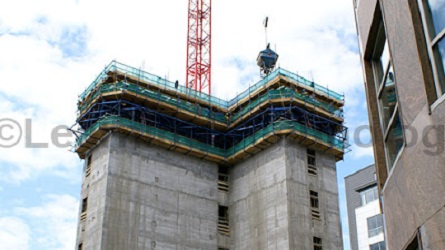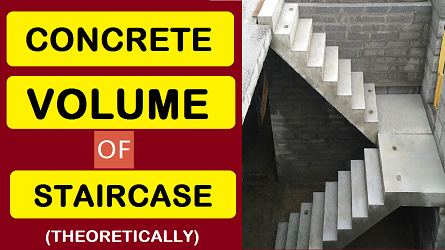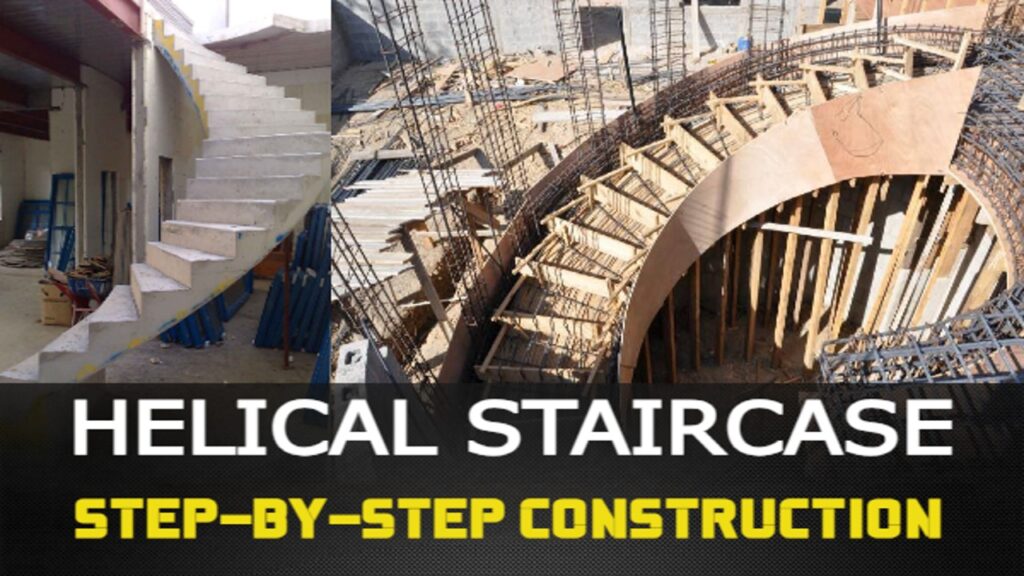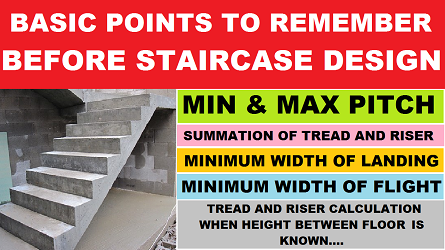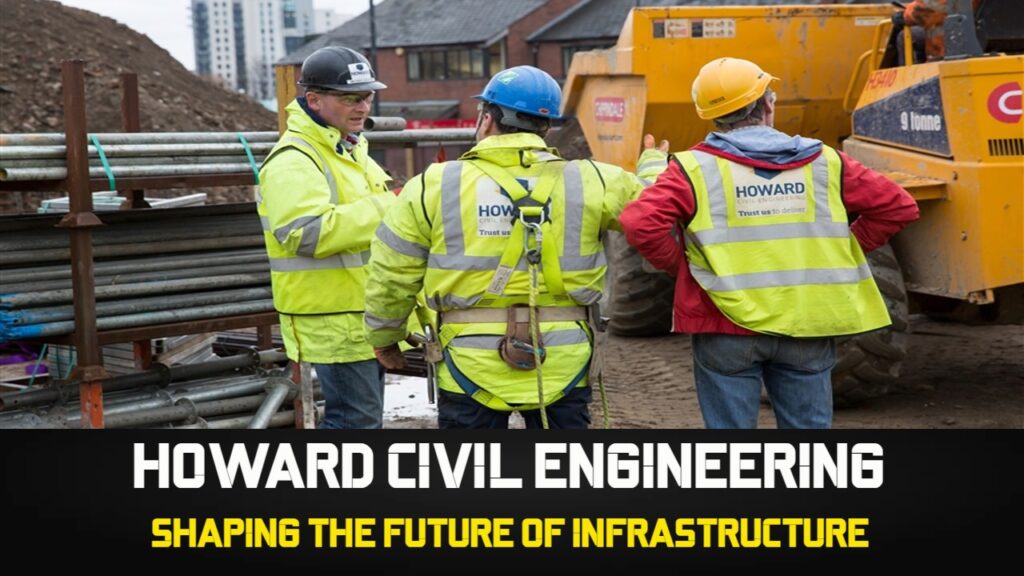Civil Engineering Interview PDF download QnA for Practical Site Interview asked in TATA, Shapoorji, L&T, Afcons, NHAI, Gammon, DBL, AAI, KEC, HPCL, NCC, BDL, Reliance Infra, Larsen Toubro
Q1. What is the minimum permissible width of Staircase landing?
Answer: The minimum permissible width of Staircase landing should be equal to the width of the flight.
Q2. Summation of Tread and Riser must lie in between –
Answer: The Summation of Tread and Riser must lie between 400 mm to 450 mm.
Q3. What should be the maximum and minimum pitch in a good stair?
Answer: The maximum pitch in a good stair should be 40 degree and the minimum pitch in a good stair should be 25 degree.
Q4. What is the minimum permissible width of the staircase flight?
Answer: The minimum permissible width of the staircase flight is 900 mm.
Q5. How to calculate the Number of Riser when the number of the tread is known to you?
Answer: The formula for Number of Riser is –
Number of Riser = Tread + 1
Q6. What is the standard size of Tread and Riser for residential buildings?
Answer: The standard size of Tread is 250 mm and Riser is 150 mm for residential buildings.
Q7. The height between two floors is 3 meters (3000 mm) and Riser = 150 mm. Assume two flights in between the two floors. Now find the Number of tread and Riser?
Answer: We know, Number of Riser = Floor to floor distance / Riser height
= 3000 / 150 = 20 Numbers
So Number of Riser is 20
Now, we know, Tread = Riser – 1 for one flight,
Here we have 2 flights.
So, Tread = Riser – 2 = 20 – 2 = 18 Numbers
Contents
- 0.0.1 For Details Watch This Video: Basic Points to Remember before about Staircase Design
- 0.0.2 For Details Watch This Video: Basic Civil Site Engineering knowledge for Interview
- 0.0.3 For Details Watch This Video: Civil Site Knowledge for Civil Engineering Student for Interview
- 0.0.4 For Details Watch This Video: Basic Important Knowledge for Civil Engineering freshers for Interview
- 0.0.5 For Details Watch This Video: Basic Important Knowledge on Timber, Stone Aggregate, Cement for Civil Engineering Interview
- 0.0.6 For Details Watch This Video: Important Basic Knowledge for Civil Engineers to know before Interview
- 0.0.7 For Details Watch This Video: Top 8 Interview Question and Answers about Self Compacting Concrete (SCC)
- 0.0.8 For Details Watch This Video: Basic Civil Engineering Useful Knowledge for Freshers Engineers
- 0.0.9 For Details Watch This Video: Imp Points to Remember from IS Codes for Interview
- 0.0.10 For Details Watch This Video: Important Interview Question and Answers about Steel Bar for Freshers and Experienced Civil Engineer
- 0.0.11 For Details Watch This Video: Important Points to Remember from IS 456 – 2000 for Interview
- 0.0.12 For Details Watch This Video: 8 Important Interview Q n Answer from IS 456 2000 for Civil Engineers
- 0.0.13 For Details Watch This Video: Basic Knowledge for Freshers Civil Construction Engineer
- 0.0.14 For Details Watch This Video: Basic Knowledge For Civil Engineering Students | Building Site Construction Interview
- 0.0.15 For Details Watch This Video: Uses of Instrument Used in Civil Engineering Construction
- 0.0.16 For Details Watch This Video: Volume of Trapezoidal Footing
- 0.0.17 For Details Watch This Video: Basic Engineering Interview Knowledge for Civil Freshers
- 1 PDF DOWNLOAD: 1 – 50 : CLICK HERE
- 2 PDF DOWNLOAD: 51 – 100 : CLICK HERE
- 3 PDF DOWNLOAD: 101 – 150 : CLICK HERE
- 4 PDF DOWNLOAD: 151 – 200 : CLICK HERE
- 5 PDF DOWNLOAD: 201 – 250 : CLICK HERE
For Details Watch This Video: Basic Points to Remember before about Staircase Design
Q8. What is the minimum diameter of the Inlet and Outlet pipe for Septic tank construction?
Answer: The minimum diameter of the Inlet and Outlet pipe for Septic tank construction is 100 mm.
Q9. Which cement is suitable for use in massive concrete structures such as large dams?
Answer: Low Heat Cement is suitable for use in massive concrete structures such as large dams.
Q10. What is the Specific gravity of Portland cement?
Answer: The Specific gravity of Portland cement is 3.15
Q11. Which IS sieve size is used to determine the fineness of cement?
Answer: The IS sieve size is used to determine the fineness of cement is 90 micron.
Q12. What is the full form of TBM?
Answer: The full form of TBM is Tunnel Boring Machine.
Q13. Name the most common admixture which is used to accelerate the initial setting of concrete?
Answer: The most common admixture which is used to accelerate the initial set of concrete is Calcium Chloride.
Q14. Which IS code is used for Concrete work measurements?
Answer: The IS 1200 Part-2 is used for Concrete work measurements.
Q15. Compared to Mild steel, Cast iron has, (i) High Compressive Strength. (ii) High Tensile Strength. (iii) Low Compressive Strength. (iv) Low Tensile Strength
Answer: Compared to Mild steel, Cast iron has i) High Compressive Strength and Low Tensile Strength.
For Details Watch This Video: Basic Civil Site Engineering knowledge for Interview
Q16. What is the compressive strength of ordinary Portland cement after three days?
Answer: The compressive strength of ordinary Portland cement after three days shall not be less than 16 MPa.
Q17. Which instrument is used to measure the Specific gravity of liquids?
Answer: Hydrometer is used to measure the Specific gravity of liquids.
Q18. What is the effect on the Bulking of Sand with an increase in moisture content?
Answer: With an increase in moisture content, the bulking of sand first increases to a certain maximum value and then decreases.
Q19. Name the main constituent of cement which is responsible for initial / Early strength of cement?
Answer: The main constituent of cement which is responsible for initial / Early strength of cement is Tricalcium Silicate.
Q20. What is the standard mortar mixing ratio of Cement and sand for testing the Compressive and Tensile strength of cement?
Answer: The standard mortar mixing ratio of Cement and sand for testing Compressive and Tensile strength of cement is 1:3.
Q21. What is the normal consistency of ordinary Portland cement?
Answer: The normal consistency of ordinary Portland cement is about 30%. As per IS 4031 Part-4, Generally it ranges between 26 to 33 percent.
Q22. What is the proportion of cement and sand for the plaster of the septic tank?
Answer: The proportion of cement and sand for the plaster of septic tank is 1:3 (1 part cement and 3 part sand).
Q23. What is the basic purpose of retarders in concrete?
Answer: The basic purpose of retarders in concrete is to increase the initial setting time of cement paste in concrete.
Q24. What is the relation between Length and Width of Septic Tank?
Answer: If L is the length and W is the width of the septic tank, then
Minimum Length = 2 x Width and Maximum Length = 4 x width
For Details Watch This Video: Civil Site Knowledge for Civil Engineering Student for Interview
Q25. What is the minimum Crushing strength of a first-class brick?
Answer: The minimum Crushing strength of a first-class brick is 10.5 N/mm2
Q26. Name the main constituent of cement which is responsible for the initial setting of cement?
Answer: The main constituent of cement which is responsible for the initial setting of cement is Tricalcium Aluminate.
Q27. Name the most commonly used retarder in concrete?
Answer: The most commonly used retarder in concrete is Gypsum.
Q28. What is the percentage of moisture content in a well-seasoned timber?
Answer: The percentage of moisture content in a well-seasoned timber is 10 to 12 percent.
Q29. What is the standard proportion of lime and sand in the mortar normally used in brick construction?
Answer: The standard proportion of lime and sand in the mortar normally used in brick construction is 1:2.
Q30. What is the proportion of cement and sand for the plaster of the septic tank?
Answer: The proportion of cement and sand for the plaster of septic tank is 1:3 (1 part cement and 3 part sand).
Q31. What is the allowable freeboard in a septic tank?
Answer: The allowable freeboard in a septic tank is 300 m to 450 mm.
Q32. Among Deodar, Chir, Shishum, and Pine, Which of the flowing trees yields hardwood?
Answer: Shishum yields hardwood.
For Details Watch This Video: Basic Important Knowledge for Civil Engineering freshers for Interview
Q33. What is the maximum water absorption for a good building stone aggregate?
Answer: The maximum water absorption for a good building stone aggregate is 5 percent.
Q34. What is the minimum crushing strength of a good building stone aggregate?
Answer: The minimum Crushing strength of a good building stone aggregate IS 100 MPa.
Q35. What causes the disease of dry rot in timber?
Answer: Lack of Ventilation causes dry rot in timber.
Q36. What is the percentage of moisture content in a well-seasoned timber?
Answer: The percentage of moisture content in a well-seasoned timber is 10 to 12 percent.
Q37. What is the average life of first-class timber?
Answer: The average life of first-class timber is more than 10 years.
Q38. What is the maximum percentage of water absorption of first-class brick?
Answer: The maximum percentage of water absorption of first-class brick is 20 percent.
Q39. What is the use of Le-Chatelier’s device?
Answer: The Le-Chatelier’s device is used for determining the soundness of cement.
For Details Watch This Video: Basic Important Knowledge on Timber, Stone Aggregate, Cement for Civil Engineering Interview
Q40. What is favorable concrete temperature limitation as per ASTM C 1064-86?
Answer: As per ASTM C 1064-86, the favorable concrete temperature limitation is from 26.7 degrees Celcius to 35 degrees Celcius.
Q41. Why we provide stirrups in Column?
Answer: We provide stirrups in the column because of mainly two important reasons. They are –
(a) To prevent from shear failure (b) To prevent from Buckling
Q42. What is the full form of HYSD bar?
Answer: The full form of #HYSD bar is High Yield Strength Deformed bars.
Q43. How many tamping strokes allowable for a #slump test?
Answer: The tamping strokes allowable for a slump test is 25 for every layer.
Q44. After what temperature use of ICE is recommended for concrete?
Answer: The use of ICE is recommended for concrete after 35 degrees Celcius.
Q45. What is the relation between Water and Strength of #Concrete?
Answer: Water is inversely proportional to the Strength of Concrete. That means, with the Increase in Water in Concrete, there is a decrease in the Strength of Concrete.
Q46. What is the full form of #CPVC?
Answer: The full form of CPVC is Chlorinated Poly Vinyl Chloride.
For Details Watch This Video: Important Basic Knowledge for Civil Engineers to know before Interview
Q47. Name the Plasticizers used for Self Compacting #Concrete?
Answer: As per IS 10262: 2019 Clause-8.3 (c), Poly Carboxylate Ethers (PCE) is an admixture that is used as Plasticizers (Water reducing admixture) to reduce water in Self Compacting Concrete (SCC).
Q48. How much water reduction is possible with Polu Carboxylate Ethers (PCE)?
Answer: As per IS 10262: 2019 Clause-8.3 (c), Use of high range water reducing admixture like polycarboxylate ether-based high range water reducing admixture (water reduction > 30 percent) and sometimes also using a viscosity modifying admixture (VMA) in appropriate dosages.
Q49. What is the desirable size of Fines for Self Compacting #Concrete?
Answer: As per IS 10262: 2019 Clause-8.3 (a), the desirable size of Fines for Self Compacting Concrete is 0.125 mm or 125 Micron.
Q50. What is the amount of Fines preferable for Self Compacting #Concrete?
Answer: As per IS 10262: 2019 Clause-8.3 (a), Sufficient amount of fines (< 0.125 mm) preferably in the range of 400 kg/m3 to 600 kg/m3, inclusive of suitable quantities of fine aggregate and mineral admixtures like fly ash in suitable proportions, may be used for flowability while ensuring compliance with engineering properties particularly shrinkage.
Q51. What is the Maximum and Minimum limitation of water for Self Compacting Concrete?
Answer: As per IS 10262: 2019 Clause-8.3 (b), the Maximum and Minimum limitation of water for Self Compacting Concrete is from 150 to 210 kg/m3
Q52. What are the main features of Fresh Self Compacting# Concrete?
Answer: As per IS 10262: 2019 Clause-7.2, A concrete mix can only be classified as self-compacting concrete, if the requirements for all below-mentioned characteristics are fulfilled:
(a) Filling ability (Flowability), (b) Passing ability, (c) Segregation resistance, and (d) Viscosity
The above tests shall be carried out as per IS 1199 (Part 6).
Q53. What is the limitation of height difference for the pouring of Concrete for the RCC column?
Answer: The limitation of the height difference for the pouring of #Concrete for the RCC column is 500 mm.
Q54. What is the Coarse aggregate size preferable for Self Compacting Concrete?
Answer: The Coarse aggregate size preferable for Self Compacting Concrete is 10 mm to 12mm.
For Details Watch This Video: Top 8 Interview Question and Answers about Self Compacting Concrete (SCC)
Q55. What is the meaning of Bored Cast in Situ?
Answer: Bored cast-in-situ pile is formed within the ground by #excavating or boring a hole within it, with or without the aid of a temporary casing (to keep the hole stabilized) and subsequently filling it with plain or reinforced concrete. These piles are particularly applicable in certain subsoil conditions where penetration to a pre-determined depth is essential.
Q56. What is the density of fire bricks?
Answer: The density of fire bricks is 2400 kg/m3
Q57. What is the minimum curing period for Mineral and #Admixture added #Cement?
Answer: The minimum curing period for Mineral and Admixture added Cement is 14 days.
Q58. What is the fundamental difference between Surveying and #Levelling?
Answer: In Surveying, the measurements are taken in the horizontal plane, but in levelling they are taken in the vertical plane.
Q59. What do you mean by the term ‘Topographical Map’?
Answer: A map that shows the natural features of a country such as Rivers, Hills, Road, Railways, Villages, Towns, etc, is known as Topographical Map.
Q60. What is the working principle of surveying?
Answer: The fundamental principle of surveying is to work from the whole to the part.
Q61. In a chaining operation, Who is the Leader, and who is the Follower?
Answer: The chainman at the forward end of the chain who drags the chain is known as the leader. The one at the rear end of the chain is known as a follower.
Q62. How many ranging rods are required to range a line?
Answer: At least three ranging rods are required for direct ranging and at least four for indirect ranging.
For Details Watch This Video: Basic Civil Engineering Useful Knowledge for Freshers Engineers
Q63. What is Fine Aggregate?
Answer: As per IS 383, Aggregate most of which passes 4.75 mm IS Sieve.
Q64. What is Coarse Aggregate?
Answer: As per IS 383, Aggregate most of which retained on 4.75 mm IS Sieve.
Q65. What is All-in-Aggregate?
Answer: As per IS 383, Material composed of both fine aggregate and coarse aggregate is known as All-in-Aggregate.
Q66. What is the minimum curing period for Super Sulphate Cement?
Answer: The minimum curing period for Super Sulphate Cement is 7 days.
Q67. Convert 1 Soot into millimetre?
Answer: 1 soot = 3.175 mm
Q68. What is Anchorage Length?
Answer: As per IS Code 13920: 2016, Clause – 6.2.5, Anchorage length equals to development length of the bar in tension and plus 10 times bar diameter minus the allowance for 90 degrees bend.
Q69. What should be the spacing considered when we use coupler in a longitudinal reinforcement bar?
Answer: As per IS Code 13920: 2016, Clause – 6.2.6.2 (b), The spacing between adjacent longitudinal bars shall be based also on the outer size of the coupler to allow easy flow of concrete.
For Details Watch This Video: Imp Points to Remember from IS Codes for Interview
Q70. What is the Rolling Margin Tolerance for Nominal mass for a 25 m diameter bar?
Answer: As per IS 1786, the Rolling Margin Tolerance for Nominal mass for 25 m diameter bar is ±3 %.
Q71. What is the allowable maximum percentage of Carbon in the manufacturing of TMT (Thermo Mechanically Treated) Bar?
Answer: As per [IS 1786, Clause- 3.2], the allowable maximum percentage of Carbon in the manufacturing of TMT (Thermo Mechanically Treated) Bar is 0.25 %
Q72. What is the Standard Length of Steel Bar taken for Rolling Margin?
Answer: The Standard Length of Steel Bar taken for Rolling Margin at Construction site is 1 meter.
Q73. What is the reference IS code used for the Bend Test of a Steel bar?
Answer: The reference IS code used for the Bend Test of a Steel bar is IS 1599.
Q74. What is the angle for the Bending of steel bar for the Bend test?
Answer: As per IS 1599, the angle for the Bending of steel bar for the Bend test is 180 degrees.
Q75. What is the diameter of the #Mandrel used for the Bend Test of Fe 500 for diameter 20 mm?
Answer: As per IS 1786, the diameter of the Mandrel used for the Bend Test of Fe 500 for diameter 20 mm is 4Φ, where Φ is the diameter of the bar.
Q76. What is the angle for the Bending of steel bar for the Rebend test?
Answer: For the Rebend test, Initially bend the bar to an included angle of 135 degrees. Keep it in boiling water at 100 degrees for 30 minutes. Then cool it down for some time. After cooling bent it back to an included angle of 157.5 degrees.
Q77. Which IS code specified for Mandrel diameter for Bend and Rebend test?
Answer: The IS code specified for Mandrel diameter for Bend and Rebend test is IS 1786.
For Details Watch This Video: Important Interview Question and Answers about Steel Bar for Freshers and Experienced Civil Engineer
Q78. What is the number of concrete cube samples taken for 6-15 cubic meter concrete?
Answer: As per IS 456: 2000 [Clause – 15.2.2], the number of concrete cube samples taken for 6-15 cubic meter concrete is 2, which consists of 6 concrete cubes. [NOTE: 1 samples = 3 test specimens = 3 concrete cube]
Q79. What is the maximum and minimum tolerance for concrete cube characteristics compressive strength result?
Answer: As per IS 456: 2000 [Clause – 15.4], the maximum and minimum tolerance for concrete cube characteristics compressive strength result is +15% and -15%.
Q80. Which grade of concrete is considered as HSC (High Strength #Concrete)?
Answer: As per IS 456: 2000 [Table – 2], the grade of concrete considered as HSC (High Strength Concrete) is M65, M70, M75, M80, M85, M90, M95, and M100.
Q81. What is the Tension and Compression zone in Cantilever Beam?
Answer: In Cantilever Beam, the Tension zone is located above the Neutral Axis and the Compression zone is located below the Neutral Axis.

Q82. What is the factor used to convert from ‘Meter’ to ‘Feet’?
Answer: To convert from ‘Meter’ to ‘Feet’ = Multiply by 3.28; To convert from ‘Feet’ to ‘Meter’ = Divide by 3.28
Q83. What is the full form of ‘BOQ’?
Answer: The full form of ‘BOQ’ is Bill of Quantities.
Q84. What is the standard Diameter of Tremie Pipe?
Answer: As per IS 456: 2000 [Clause – 14.2.4(a)], The tremie pipe shall be not less than 200 mm in diameter and shall be large enough to allow a free flow of concrete and strong enough to withstand the external pressure of the water in which it is suspended, even if a partial vacuum develops inside the pipe.
Q85. What is the Effective depth of #beam?
Answer: As per IS 456: 2000 [Clause – 23], Effective depth of a beam is the distance between the centroid of the area of tension reinforcement and the maximum compression fiber, excluding the thickness of finishing material not placed monolithically with the member and the thickness of any concrete provided to allow for wear. This will not apply to deep beams.
For Details Watch This Video: Important Points to Remember from IS 456 – 2000 for Interview
Q86. What is the maximum quantity of cement we can use per cubic meter of concrete?
Answer: As per IS 456: 2000 [Clause – 8.2.4.2], the maximum quantity of cement we can use per cubic meter of concrete is 450 kg. Cement content not including fly ash and ground granulated blast furnace slag in excess of 450 kg/m3 should not be used unless special consideration has been given in the design to the increased risk of cracking due to drying shrinkage in thin sections, or to early thermal cracking and to the increased risk of damage due to alkali-silica reactions.
Q87. What is the minimum quantity of cement required for M25 grade of concrete for Moderate condition?
Answer: As per IS 456: 2000 [Table-5], the minimum quantity of cement required for M25 grade of concrete for Moderate condition is 300 kg/m3
Q88. Which grade of concrete termed as Nominal Mix Design?
Answer: As per IS 456: 2000 [Clause – 9.3], Nominal Mix Concrete may be used for concrete of M20 or Lower.
Q89. What is the maximum percentage dosage of retarder we can use?
Answer: As per IS 456: 2000 [Clause – 10.3.3], the maximum percentage dosage of retarder we can use is 0.5 percent by weight of cementitious materials.
Q90. What is the allowable tolerance for Concrete Cover size?
Answer: As per IS 456: 2000 [Clause – 12.3.2], the Actual concrete cover should not deviate from the required nominal cover by +10 mm and -0 mm.
Q91. What is the minimum curing period required when we use blended cement in construction?
Answer: As per IS 456: 2000 [Clause – 13.5.1], the minimum curing period required when we use mineral admixtures or blended cement in construction is 10 days.
Q92. What is the Slump value for Pumped #concrete?
Answer: As per IS 456: 2000 [Clause – 7.1], the Slump value for Pumped concrete is (75 – 100) mm.
Q93. What is the maximum percentage dosage of #plasticizers we can use?
Answer: As per IS 456: 2000 [Clause – 10.3.3], the maximum percentage dosage of plasticizers we can use is 1.0 percent by weight of cementitious materials.
For Details Watch This Video: 8 Important Interview Q n Answer from IS 456 2000 for Civil Engineers
Q94. What are the functions of #Bentonite?
Answer: The main uses of bentonite are for drilling mud, binder (e.g. foundry-sand bond, iron ore pelletizer), purifier, absorbent (e.g. pet litter), and as a groundwater barrier. In other words, we can say, Bentonite stabilizes the Soil.
Q95. What is the ultimate load capacity of Pile in civil engineering?
Answer: The maximum load which a pile can carry before failure, that is, when the founding strata fail by shear as evidenced from the load settlement curve or the pile fails as a structural member.
Q96. What are the minimum criteria to provide Expansion Joint in Building Works in civil engineering?
Answer: As per IS 456: 2000 (Clause- 27.2), Normally structures exceeding 45 m in length are designed with one nor more expansion joints.
Q97. What are the factors affecting Development Length?
Answer: The factors affecting Development Length are:
a) Grade of Steel b) Grade of Concrete c) Diameter of Bar
Q98. What is the function of Frog in Brick in civil engineering?
Answer: Frog in Brick helps in developing proper joint between brick and mortar.
Q99. Which steel is used in the manufacture of Rail?
Answer: Manganese steel is used in the manufacture of Rail.
Q100. What type of cement is used in Sea Water Construction?
Answer: As per IS 456: 2000 (Clause-8.2.8), the type of cement used in Sea Water Construction are PSC (Portland Slag Cement) and PPC (Portland Pozzolana Cement)
Q101. What are the factors used to convert from N/mm2 to Kg/cm2?
Answer: To convert from N/mm2 to Kg/cm2 = Multiply by 10.197 ; To convert from Kg/cm2 to N/mm2 = Divide by 10.197
For Details Watch This Video: Basic Knowledge for Freshers Civil Construction Engineer
Q102. In plastering what is known as 1st coat?
Answer: In plastering, 1st coat is known as Undercoat.
Q103. In M50, What is ‘M’ and ‘50’?
Answer: ‘M’ stands for ‘Mix’ and ‘50’ is known as Characteristics Compressive Strength of Cube of 150 mm x 150 mm x 150 mm in size after 28 days of curing in N/mm2
Q104. Difference between Development length and lap length?
Answer: Development Length transfers the Stress from Reinforcement to Concrete whereas Lap length transfers the stress from one bar to another bar.
Q105. What is the size of mould to check the compressive strength of #cement?
Answer: As per IS 10080 : 1982, the size of mould to check the compressive strength of cement is 70.6 mm x 70.6 mm x 70.6 mm
Q106. What is the percentage strength of concrete after 28 days of curing?
Answer: The percentage strength of concrete after 28 days of curing is 99%.
Q107. What is the conversion factor to convert from square meter to square feet in civil engineering?
Answer: The conversion factor to convert from square meter to square feet is 10.764
Q108. As per US gallon, how many liters in 1 gallon in civil engineering?
Answer: As per US gallon, 1 Gallon = 3.785 Litres
Q109. Which IS code is used for the reference for Earthquake force in civil engineering?
Answer: IS 1893 is used for the reference for Earthquake force.
For Details Watch This Video: Basic Knowledge For Civil Engineering Students | Building Site Construction Interview
Q110. What are the uses of Cover Block in civil engineering?
Answer: A) It protects reinforcement from Thermal Expansion during the fire. B) It protects reinforcement from Corrosion.
Q111. What is the use of Plumb Bob in civil engineering?
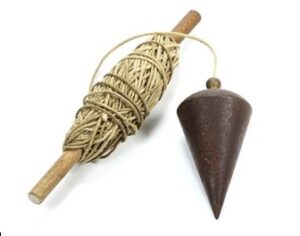
Answer: A) It is used to provide vertical datum lines for the building measurements. B) It is used to check the Verticality of Column, Wall or any other Flat Vertical Surface. C) A plumb bob can be used to mark a reference point above or below a given point.
Q112. What is the use of the Right angle in civil engineering?
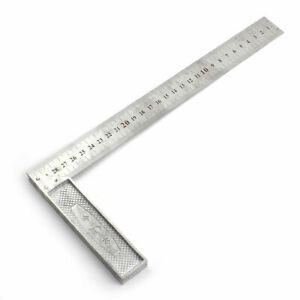
Answer: It is used to place the object at the right angle (90 degrees). It is also used in the layout of the wall to set the corresponding wall at the right angle to each other. It is also used to set the Skirting at the right angle with respect to Floor.
Q113. What is the use of Sprit level in civil engineering?

Answer: A spirit level, bubble level or simply a level is an instrument designed to indicate whether a surface is horizontal (level) or vertical (plumb). Different types of spirit levels may be used by carpenters, stonemasons, bricklayers, other building trades workers, surveyors, millwrights, and other metalworkers, and in some photographic or video graphic work.
Q114. What is the use of HILTI PD-5 (Laser Meter) in civil engineering?
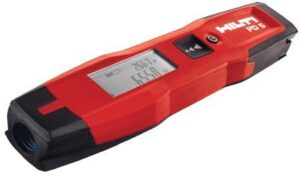
Answer: It is used to measure Horizontal and Vertical distance between two walls or any two partitions.
Q115. What is the use of Hydrometer?
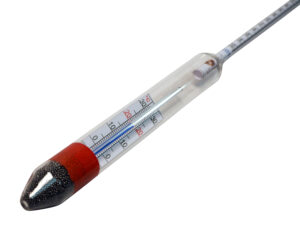
Answer: Hydrometer is used to measure the Specific Gravity (or Relative density) of liquids.
Q116. What is the use of Level Pipe Tube?
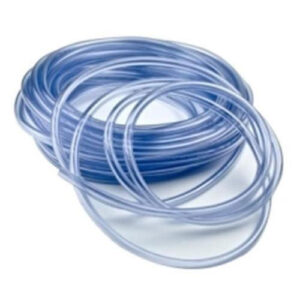
Answer: Level pipe tube is used to transfer the existing level from one place to another. It is also used to check all points of the wall are at the same level or not.
Q117. What is the use of Line Dori?
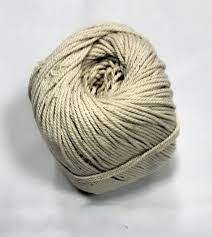
Answer: Line Dori is a wire or thread used to align the wall, beam, and other building elements during construction.
Q118. What is the use of #Coupler?
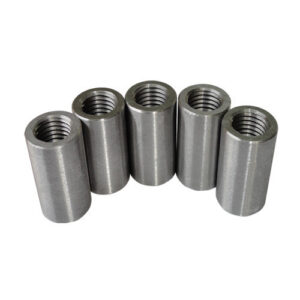
Answer: A steel coupler is used to couple or join two pieces of steel together in the building or any other civil works.
For Details Watch This Video: Uses of Instrument Used in Civil Engineering Construction
Q119. What is the unit weight of concrete?
Answer: Unit weight of Plain Cement Concrete (PCC) is 2400 kg/m3 and Unit weight of Reinforced Cement Concrete (RCC) is 2500 kg/m3
Q120. What is the least count of Prismatic Compass?
Answer: The least count of Prismatic Compass is 30’ (30 Minutes).
Q121. What are the steps involved in the Concreting process?
Answer: The steps involved in the Concreting process are as follows:
(A) Batching (B) Mixing (C) Transporting (D) Placing (E) Compacting
Q122. What are the Initial Setting Time and Final Setting Time of Cement?
Answer: The Initial Setting Time of Cement is 30 minutes and the Final Setting Time of Cement is 600 minutes (10 hours).
Q123. What is the formula for the volume of Trapezoidal Footing?
Answer: Volume of Trapezoidal footing = Volume of Cuboid + Volume of Truncated Pyramid
The Volume of Cuboid = L x B x H
The volume of Truncated Pyramid =

Where,
A1 = Area of Top Base ; A2 = Area of Bottom Base ; h = Height
Volume of Trapezoidal Footing

For Details Watch This Video: Volume of Trapezoidal Footing
Q124. What is the size of Frog in Brick as per IS 1077?
Answer: As per IS 1077, the size of the Frog in brick is as follows:
Length = 100 mm ; Breadth = 40 mm ; Thickness = 10 mm to 20 mm
Q125. Name the IS Code used for Bending and Fixing of Bars for Concrete Reinforcement?
Answer: The IS Code used for Bending and Fixing of Bars for Concrete Reinforcement is IS 2502.
Q126. What is the Least Count of Theodolite?
Answer: The least count of Theodolite is 15” (15 seconds) and 20” (20 seconds).
For Details Watch This Video: Basic Engineering Interview Knowledge for Civil Freshers
Q127. What is the fundamental difference between Surveying and Levelling?
Answer: In Surveying, the measurements are taken in the horizontal plane, but in Levelling, they are taken in the vertical plane.
Q128. What is the fundamental difference between Plane surveying and Geodetic surveying?
Answer: In the Plane surveying, the curvature of the earth is not considered. But in Geodetic surveying, the curvature of the earth is considered.
Q129. What do you mean by the terms ‘ Topographical map’ and ‘Cadastral map’?
Answer: A map which shows the natural features of a country such as rivers, hills, roads, railways, villages, towns etc. It is known as Topographical map and one which shows the boundaries of estates, fields, houses, etc. It is known as a Cadastral map.
Q130. What is the main principle of Surveying?
Answer: The fundamental principle of surveying is to work from the whole to the part.
Q131. How is a chain folded and unfolded?
Answer: In order to fold the chain, a chainman moves forward by pulling the chain in the middle so that two halves come side by side. Then he places the pair of links on his left hand with his right hand until the two brass handles appear at the top.
Q132. In a chaining operation, who is the leader and who is the follower?
Answer: The chainman at the forward end of the chain who drags the chain is known as the leader. The one at the rear end of the chain is known as the follower.
Q133. While chaining a line, you have to measure through a steep sloping ground. What method should you apply?
Answer: The Stepping method.
Q134. Two stations are not intervisible due to intervening high ground. How will you range the line?
Answer: The range is to be done by the reciprocal method.
Q135. What do you mean by normal-tension?
Answer: The tension at which the measured distance is equal to the correct distance (i.e. when sag correction is neutralised by pull correction) is known as normal tension.
Q136. What do you mean by RF?
Answer: The ratio of the distance on the drawing to the corresponding actual length of the object is known as RF.
Q137. What is the difference between the Plain scale and the Diagonal scale?
Answer: The Plain scale represents two successive units. The diagonal scale represents three successive units.
Q138. What is a hypotenusal allowance?
Answer: When one chain length is measured on sloping ground, then it shows a shorter distance on the horizontal plane. The difference between the sloping distance and horizontal distance is known as the Hypotenusal allowance.
Q139. How many ranging rods are required to range a line?
Answer: At least three ranging rods are required for direct ranging, and at least four for indirect ranging.
Q140. What is the length of one link in a 20 m chain?
Answer:The 20 m chain is divided into 100 links. So, one link is 0.2 m, i.e., 20 cm long.
Q141. What is the Minimum Length of Hook?
Answer: 75 mm
Q142. What are the factors on which Development Length Depends?
Answer: Grade of Concrete, Grade of Steel
Q143. What is the purpose of Frog in Brick?
Answer: It helps in developing a proper joint between Brick and mortar.
Q144. Which steel is used in the manufacture of rails?
Answer: Manganese Steel
Q145. What type of cement is preferable in seawater construction?
Answer: Slag or Pozzolana (PSC or PPC) as per IS 456 : 2000 Cl. 8.2.8
Q146. What should be the pH of water used in concrete?
Answer: As per IS 456: 2000 Cl. 5.4.2, pH of water shall be not less than 6
Q147. How to convert N/mm2 to Kg/cm2?
Answer: Multiplying by 10.197
Q148. What is the minimum lap length taken in the Compression zone?
Answer: As per IS 456: 2000 Cl. 26.2.5.1(d), the lap length in compression shall not be less than 24ᶲ, where ᶲ is the diameter of the bar.
Q149. When bars of two different diameters are to be lapped, then lap length will be calculated on the basis of which dia?
Answer: As per IS 456: 2000 Cl. 26.2.5.1(e), the lap length shall be calculated on the basis of the diameter of the smaller bar.
Q150. When we will provide side face reinforcement in the beam?
Answer: As per IS 456: 2000 Cl. 26.5.1.3, When the depth of the web in a beam exceeds 750 mm, side face reinforcements shall be provided along with the two faces.
Q151. What is the function of Column in the building?
Answer: Column is a vertical member of a building that support structural load transferred by the whole structure through Beams. After that column transfers the load to the Footing and finally Footing transfers the load to the land.
Q152. When the possibility of Segregation of concrete is more?
Answer: a) When the water-cement ratio is high, b) If the ratio of coarser aggregate is much more than the other proportion, c) Coarser grading
Q153. What is the least cover provided for different RCC members in civil engineering?
Answer: Footing – 50 mm, Column – 40 mm, Beam – 25 mm, Slab – 20 mm.
Q154. What is the full form of TMT bar?
Answer: Thermo Mechanical Treatment.
Q155. What do you mean by Honeycomb in Concrete?
Answer: Honeycomb means Void. It is also known as Air Pocket.
Q156. What are Deflection and Deformation in civil engineering?
Answer: Deflection is temporary displacement whereas Deformation is permanent displacement.
Q157. What are the methods of curing in civil engineering?
Answer: (a) Spraying, (b) Wet covering of a surface, (c) Ponding, (d) Application of curing compound, (e) Steam curing.
Q158. The formula for calculating the unit weight of the round section TMT bar?
Answer: (D)square/162, where ‘D’ is the dia of a bar in mm.
Q159. What is the unit weight of concrete in civil engineering?
Answer: As per IS 456:2000, the Unit weight of PCC is 2400 Kg/Cum & Unit weight of RCC is 2500 Kg/Cum
Q160. What is the Nominal Concrete mix proportion for different grades in civil engineering?
Answer: M5 – 1:5:10, M7.5 – 1:4:8, M10 – 1:3:6, M15 – 1:2:4, M20 – 1:1.5:3, M25 – 1:1:2
Q161. In plastering, what is known as 1st coat?
Answer: Undercoat.
Q162. What is Bentonite in civil engineering?
Answer: It is a Montmorillonite clay with a very high liquid limit.
Q163. What is the meaning of M50?
Answer: Here ‘M’ stands for ‘Mix’. 50 stands for Characteristics compressive strength of concrete cube size 150 mm x 150 mm x 150 mm, after 28 days curing. Its unit is N/mm2
Q164. Difference between Development length & Lap Length?
Answer: Lap length addresses the length of the bar needed to transfer the stress to the other bar, whereas Development length addresses the length of the bar needed to transfer the stress to the concrete.
Q165. Which instrument is used to measure Specific Gravity?
Answer: Hydrometer
Q166. What is the size of the mould used to measure the compressive strength of Cement?
Answer: As per IS 10080: 1982, The size is 70.6 mm x 70.6 mm 70.6 mm
Q167. What is the percentage strength of concrete with time?
Answer: After 1 day – 16%, After 3 days – 40%, After 7 days – 65%, After 14 days – 90%, After 28 days – 99%
Q168. How to Convert Square meter to Square feet?
Answer: Multiplying by 10.764
Q169. As per US Gallon, 1 Gallon equals how much liters?
Answer: 3.785 Litres
Q170. Which IS code Illustrates the Earthquake force in civil engineering?
Answer: IS 1893
Q171. What is the use of the Cover block in civil engineering?
Answer: It protects the reinforcement from thermal expansion during a fire or excessive heat. It also protects the steel from corrosion.
Q172. What is the use of Plumb Bob in civil engineering?
Answer: It is used to find the verticality of any object.
Q173. Is maximum height permissible for the free fall of concrete?
Answer: As per [IS 456:2000 Clause – 13.2], It is 1.5 m
Q174. What is the maximum dia of a bar we can use in a slab?
Answer: As per IS 456: 2000 Cl. 26.5.2.2, The dia of reinforcing bar shall not exceed 1/8 th of the total thickness of the slab.
Q175. What is the ultimate load capacity of a pile?
Answer: The maximum load which a pile can carry before failure.
Q176. When we will provide Expansion joints in civil engineering?
Answer: As per [IS 456:2000, Clause 27.2], Structure exceeding 45 meters in length are designed with one or more expansion joints.
Q178. What is the minimum height of the Parapet wall?
Answer: 1 meter.
Q179. What is the maximum spacing between 2 chairs or spacers bar in a slab?
Answer: 1 meter.
Q180. As per IS code 456:2000, what is the minimum dia of the main bar in a column?
Answer: 12 mm.
Q181. What is a Two-way Slab in civil engineering?
Answer: If the ratio of Longer Span to Shorter Span is less than 2, then it is called a Two-way slab.
Q182. What is Kentledge in civil engineering?
Answer: It is a dead weight used for applying a test load on a pile.
Q183. What is the #reinforcement criteria for the beam?
Answer: As per 13920: 2016 Cl. 6.2.1, Beam shall have at least two numbers 12 mm dia bar each at the top and bottom faces.
Q184. What is the percentage of water we can increase for every 25 mm slump?
Answer: As per IS 10262: 2009 Cl. 4.2, We can increase 3% for every additional 25 mm slump.
Q185. As per UK gallon, 1 Gallon equals how much liters in civil engineering?
Answer: 4.54 Litres
Q186. In one way slab, the Main bar is provided along which span?
Answer: Shorter span
Q187. How we can measure the thickness of the Plaster?
Answer: Bull mark is provided at a specific distance to make sure that the required thickness of the Plaster is uniform throughout.
Q188. In plastering, What is known as 2nd coat?
Answer: Floating coat
Q189. What is the specific gravity range of Bentonite slurry during Piling?
Answer: 1.05 to 1.12
Q190. What is the working load in civil engineering?
Answer: The load assigned to a pile as per design.
Q191. What is the use of the Damp Proof Course?
Answer: It prevents moisture from rising up the wall from the ground.
Q192. What is a small and large diameter pile?
Answer: As per IS 2911, Part – 1, Section – 2, Piles of 600 mm or less in diameter are called small diameter pile and Piles greater than 600 mm in diameter are called large diameter pile.
Q193. What is Friction Pile in civil engineering?
Answer: If the pile supports the load primarily by friction along its surface, then it is called Friction Pile.
Q194. How much CFT in 1 bag of Cement (50 KG)?
Answer: 1.225 Cubic Feet
Q195. What are the factors affecting the strength of concrete?
Answer: Quality of Raw Materials, Water – Cement Ratio, Coarse – Fine aggregate ratio, Aggregate – Cement ratio, Curing period, Temperature, Compaction of concrete.
Q196. What is the density of Ice?
Answer: 920 Kg per Cubic meter.
Q197. What is the Contour Line in civil engineering?
Answer: A line joining points of equal elevation is known as a Contour Line.
Q198. What is the least count of theodolite?
Answer: The difference between the value of the smallest division of the main scale and that of the smallest division of the vernier scale known as the least count of the theodolite. It is the least value that can be measured by theodolite.
Q199. What is the function of Bentonite?
Answer: It stabilizes the soil
Q200. What is the standard thickness of Ceiling Plaster?
Answer: 6 mm
Q201. What is a One-way slab in civil engineering?
Answer: If the ratio of Longer Span to Shorter Span is more than or equal to 2, then it is known as One way Slab.
Q202. What is the formula for calculating Riser in Staircase?
Answer: Riser = Tread + 1
Q203. Which Zone Sand is suitable for the Plaster?
Answer: Zone – 3
Q204. Why we provide Alternate Bent Up bar in a slab?
Answer: To resist Negative Bending Moment
Q205. Which Code do we use for Concrete Mix Design in civil engineering?
Answer: IS 10262: 2009
Q206. What is the size of Cube taken for Compressive Strength Test?
Answer: 150 mm x 150 mm x 150 mm
Q207. What is the weight of Cube of Size 150 mm x 150 mm x 150mm?
Answer: 8.1 Kg
Q208. What is the meaning of 43 grade, 53 grade on Cement bags?
Answer: Cement grade indicates the Compression strength of cement after 28 days of setting.
Q209. How to calculate the number of stirrups?
Answer: Number of Stirrups =[ (Length of Span/Spacing of Stirrups) + 1 ]
Q210. What is Transit Theodolite?
Answer: A transit Theodolite is one in which the telescope can be revolved completely about the horizontal axis in a vertical plane.
Q211. What are the functions of a theodolite?
Answer: The function of a theodolite is to measure the following quantities: a) Horizontal angle, b) Vertical angle, c) Deflection angle, d) Magnetic Bearing, e) Horizontal Distance
Q212. What is the standard thickness of Putty?
Answer: 3 mm
Q213. Which Zone sand is suitable for Filling purpose?
Answer: Zone – 4
Q214. What is the Standard thickness of mortar for bedding of Flooring?
Answer: 35 mm
Q215. What is the standard size of a modular brick?
Answer: 190 mm x 90 mm x 90 mm
Q216. What is the standard thickness of External Plaster?
Answer: 19 mm
Q217. Which Zone sand is suitable for Concrete?
Answer: Zone – 2
Q218. What is the standard thickness of the Internal Plaster?
Answer: 12 mm
Q219. What is the full form of AAC Block in civil engineering?
Answer: Autoclaved Aerated Concrete
Q220. What is the volume of 1 bag Cement?
Answer: 0.0347 Cubic meter
Q221. What is the name of Binding wire used in construction?
Answer: Black Annealed Wire
Q222. What is ductility in civil engineering?
Answer: Ductility is the ability to deform under tensile stress.
Q223. What is the length of riser and tread in staircase?
Answer: Riser – 150 mm to 200 mm; Tread – 250 mm to 300 mm.
Q224. What is the slope of the staircase?
Answer: As per IS 456:2000, the slope or pitch of stairs should be between 25 degrees to 40 degrees.
Q225. What do you mean by Segregation in civil engineering?
Answer: Segregation is a separation of Cement, Sand from Aggregate.
Q226. What is the Initial and Final setting time of cement in civil engineering?
Answer: Initial – 30 mins; Final – 10 hours.
Q227. What is Bleeding in concrete in civil engineering?
Answer: Bleeding is one form of segregation, where water comes out to the surface of the concrete.
Q228. What is the name of the machine to do a Compression test in civil engineering?
Answer: Universal Testing Machine (UTM)
Q229. What is the function of stirrups in civil engineering?
Answer: Stirrups are provided to resist the Shear force. It also holds the main bars in position.
Q230. What is the total length of the steel bar?
Answer: 12 m
Q231. What is Soil Reinforcement in civil engineering?
Answer: Soil reinforcement is the act of improving soil strength to enable it to support or carry more load.
Q232. Why foundations are placed below ground level in civil engineering?
Answer: To increase the stability of the structure.
Q233. What is the use of the 3-4-5 method in construction sites in civil engineering?
Answer: This method used for setting out plans accurately at the right angle.
Q234. What is the full form of DPC?
Answer: Damp Proof Course.
Q235. What is the minimum recommended diameter of bored cast-in-situ pile?
Answer: As per [IS 2911, Part – 1, Section – 2], the minimum recommended diameter of the pile is 450 mm.
Q236. What is the full form of RCC?
Answer: Reinforced Cement Concrete.
Q237. What is the angle of Hook in Stirrups?
Answer: 135 degrees.
Q238. What is the factor that helps in converting Wet concrete volume to Dry concrete volume?
Answer: 1.54
Q239. How to Convert Cubic meter to Cubic Feet?
Answer: Multiplying by 35.3147
Q240. What is the direction of the Main & Distribution bar in RCC Slab?
Answer: Main bar in Shorter span and Distribution bar in a longer span.
Q241. What is End Bearing Pile in civil engineering?
Answer: If the pile supports the load primarily by resistance developed at the pile tip or base, then it is called End Bearing Pile.
PDF DOWNLOAD: 1 – 50 : CLICK HERE
PDF DOWNLOAD: 51 – 100 : CLICK HERE
PDF DOWNLOAD: 101 – 150 : CLICK HERE
PDF DOWNLOAD: 151 – 200 : CLICK HERE
PDF DOWNLOAD: 201 – 250 : CLICK HERE
I hope you find this civil engineering interview information useful. If there is something that I have missed civil engineering or I do not know, you can comment and tell me which I will try to rectify as soon as possible. | civil engineering
You can also follow me on Instagram, Telegram and Facebook page for civil engineering. Because many small things, which are very important from interview point of view, it is not possible to put here, I put all that on Instagram, Telegram and Facebook page for civil engineering. You can take it from there. You will find the links of all social media below. | civil engineering |
INSTAGRAM | TELEGRAM | FACEBOOK PAGE
If you have liked this post of mine for civil engineering, then use the social link given below and share it among your friends on social media. Thanks

